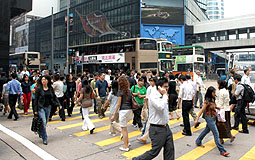 |
| Live long, prosper: Hong Kong enjoys a low mortality rate, and expectations of life at birth for both sexes compare favourably with those in low-mortality economies such as Japan, Sweden and Norway. |
|
|
The labour force participation rate will fall to 55% in 2026, from 61.5% now, due to the aging population, according to a Census & Statistics projection.
It expects the total labour force to rise from 3.63 million in 2007 to 3.88 million in 2018, then fall to 3.82 million in 2026.
The Hong Kong Labour Force Projections for 2007 to 2026, released today, suggests the labour force participation rate for young people aged 15 to 24 will fall to 37.9% in 2026, from 43% in 2007, due to rising opportunities for them to attain upper secondary and tertiary education.
People aged 25 to 29 will have the highest labour force participation rate in the coming 20 years, at around 91%. Those aged 30 to 39 will see their participation rate rise from 86% to 89.6%, while those aged 40 to 49 will see their rate rise from 79.5% to 83.8% - a result of more women in these age groups joining the labour market.
The economically inactive population is projected to be 3.19 million in 2007, 3.59 million in 2018 and 4.13 million in 2026. The ratio of the labour force to the economically inactive population is 1.14:1 for 2007, 1.08:1 for 2018 and 0.93:1 for 2026.
Mortality trend
On Hong Kong's mortality trend from 1981 to 2006, the number of deaths rose to 37,457 in 2006, from 24,832 in 1981. However, the standard death rate dropped 39%, from nine per 1,000 population in 1981 to 5.5 in 2006.
Mortality varies significantly with age. From 1981 to 2006, the greatest improvement in mortality was among infants. The death rates dropped 73% for boys and 71% for girls. The fall in mortality rates for seniors, though, is only minimal.
Tumours, circulatory- and respiratory-system diseases were still the main causes of deaths in the period from 2001 to 2006. The percentages of male and female deaths from tumours both dropped two percentage points, to 36% and 29%.
The percentages of male deaths for circulatory-system diseases rose by about a percentage point to 23%, while those for respiratory-system diseases rose by about two percentage points to 19%. The corresponding figures for women remained stable at around 29% and 16%.
In 1981, the expectations of life at birth were 72.3 years for men and 78.5 years for women. By 2006, the corresponding figures had risen to 79.4 years and 85.5 years, indicating a substantial improvement in mortality over the period.
Compared with other economies, Hong Kong enjoys a very low mortality. Expectations of life at birth for both sexes compare favourably with those of low-mortality economies such as Japan, Sweden and Norway.
People can find more details about the two studies in the Hong Kong Monthly Digest of Statistics December 2007 issue, which can be downloaded here.
Go To Top
|



